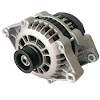CONSTRUCTION AND WORKING OF SOLAR POWER PLANT
The Sun is a primary source of energy. The energy from the sun that is reaches the earth is called solar energy. The Sun is 150 million kilometers away from the earth. Solar energy appears to be most promising among the non-Conventional source of energy and also it doesn’t contaminate the atmosphere and it is inexhaustible source.
Sun radiates energy of about 3.5 x 1023 KW in to space and only 2 x 1014 KW reaches to earth. The energy emitted by sun within three minutes is equivalent to the word energy emitted by sun within three minutes is equivalent to the world energy consumption during a year.
May researches are being going on
for effective conversion of solar energy into electrical energy. In this method
the solar radiation is converted into heat energy which is further converted into
Mechanical and Electrical energy.
The
basic elements of a solar power plant are shown in fig 1.1. It basically
consists of large parabolic collectors for collecting solar energy, which is
used to heat a fluid (water, sodium, gases etc,). This collector system results
in temperatures of about 1500 C to 5000 C in the heat
transfer medium (fluid). When the transfer medium is water steam can be
generator directly in the receiver.
FIG: Solar power plant
Solar
energy is not available in all time. Hence some form of heat energy storage is
necessary. One form of storage can be pressure vessel storing water and steam
at a temperature near the boiling point. Whenever necessary water is converted
into steam.
The solar heat from the receiver or storage converts feed water into steam this steam is utilized to run a prime-move (steam turbine) coupled to an electric generator, which generates electric power. Steam is condensed in the condenser and water returns to the boiler for reuse as feed water. The condensed can be utilized for some other purpose.
Advantages of Solar Power:
1. Solar energy is free, and hence it needs no fuel
2. In sunny countries, solar power can be used where there is no easy way to get electricity to a remote place.
3. Utilized for low-power uses such as solar powered garden lights and battery changes,
4. Non-exhaustible
5. It is clean and free from environmental pollution.
6. It can be utilized without highly specialized skills.
Disadvantages of Solar power
1. Doesn’t work at night.
2. Very expensive to build solar power station.
3. Solar cells costs a great deal compared to the amount of electricity they will produce in their lifetime.
4. Can be Unreliable unless, it is very sunny Climate.
5. Conversion of solar energy into Useful from requires a large capital investment.










0 Comments